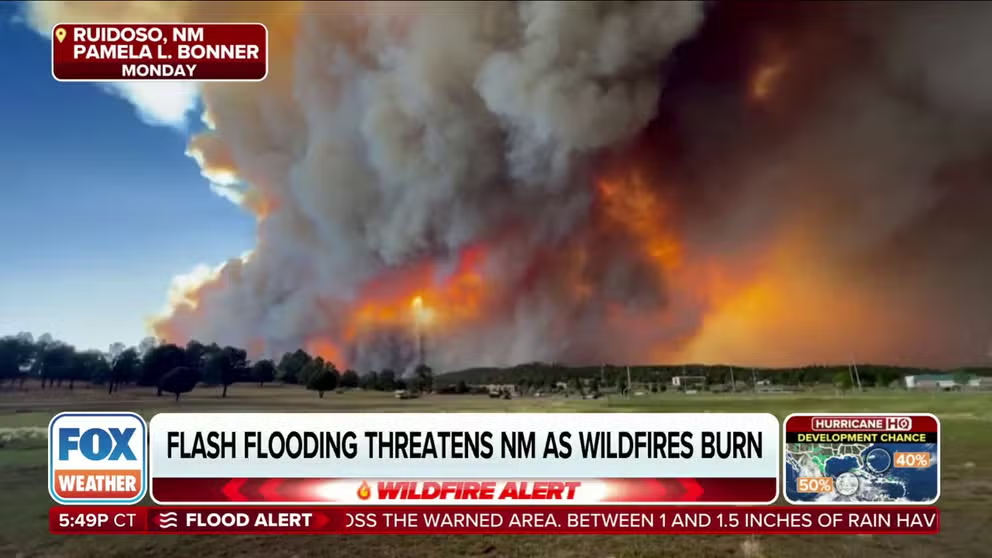California’s early explosive wildfire season is nearly 1,500% ahead of last year
Early in California's fire season 90,000 acres have burned, more than 5 times the 5-year average, according to CAL Fire. Fires across the U.S. have burned more than 2.1 million acres among more than 19,000 fires. This is fewer total fires, but more acres burned than the 10-year average.
Wildfire season heats up in Southwest, California with several large blazes
Thousands have been forced to evacuate in New Mexico ahead of a massive blaze. Weather patterns are making fire outlooks rather complex as the region experiences a rather relaxed monsoon pattern.
California’s summer is off to a hazy start as multiple massive wildfires fueled by hot temperatures and gusting winds are fueling the state's explosive start to wildfire season.
So far in 2024, fires have consumed nearly 90,000 acres in California. Last year, by mid-June, wildfires burned about 5,700 acres. This year’s fire season has already consumed more than 5 times the 5-year average burned by this time, according to CAL Fire.
CAL Fire said the number of wildfires is up 9% this spring. However, the acres burned have "skyrocketed" by 1,462% and 95% of fires are human-caused, fueled by dry grasses and strong winds.
HOW TO BEST PREPARE YOUR HOMES FOR WILDFIRES
Most of the acres burned were from two of the largest wildfires outside of major cities, including Los Angeles and San Francisco.
The Post Fire in Los Angeles County near Gorman exploded in size over the weekend, burning nearly 16,000 acres.
"Obviously, this is early in the season, and we are encountering the biggest fire right now in California, early in June," Los Angeles County Fire Department Public Information Officer Marco Rodriguez told FOX Weather. "And so we are getting ready for a potential busy fire season."
The Sites Fire in Colusa County, burning northeast of Sonoma, has consumed more than 19,000 acres.
Evacuations were ordered in Calaveras County from the Aero Fire, and the Point Fire burning in Sonoma County consumed more than 1,200 acres, sending smoke throughout the region.
The weather has driven fire behavior in California in recent weeks, said Nick Bond, Washington State Climatologist emeritus.
SATELLITE IMAGERY SHOWS MASSIVE HABOOB OVERTAKING PARTS OF DESERT SOUTHWEST, MEXICO
"Fires get set all the time, and we get extreme behavior when there are strong winds that fan them," Bond said. "And that's what has happened in California, basically a very, deep trough aloft, upstream of that big ridge of high pressure that's leading to the heat east of the Mississippi. That has produced a pressure pattern with a really strong winds and rugged terrain."
Throughout Central and Southern California, air quality ratings on the Air Quality Index have ranged from moderate to unhealthy this week as fires continue to burn and winds shift smoke into more areas.

(FOX Weather)
More than 2.1 million acres burned
Wildfire season didn’t just get an early start in California.
According to the National Interagency Fire Center, fires across the U.S. have burned more than 2.1 million acres, among more than 19,000 fires. This is fewer total fires, but more acres burned than the 10-year average, according to NIFC data.
Between two wildfires in New Mexico, more than 1,400 structures were burned and 2 people were killed, threatening the tribal and government lands surrounding Ruidoso. Dynamic weather and shifting winds helped the fire quickly spread.
Deadly New Mexico fires burn out of control despite thunderstorms
The Salt and South Fork fires in New Mexico continue to grow with firefighters unable to get any containment. On top of that severe thunderstorms dropped baseball-sized hail and triggered flash flooding in the burn scars. Fox News Reporter Kennedy Hayes takes us to the fire lines.
"Grass and brush fires can move almost as fast as the wind. And, in places in the West, with limited access routes, what you don't want to be is stuck with your escape routes cut off," Bond said.
For the West and Southwest, one reason for the fire activity is the record rain from atmospheric rivers that rolled through between fall 2023 and early 2024.
4 FIREFIGHTERS INJURED BATTLING NEW BLAZE IN CALIFORNIA’S NAPA VALLEY AMID 100+ DEGREE HEAT
While the rain improved drought conditions, it also provided the water needed for brush to regrow. With record temperatures in California early this summer amid multiple heat waves, the brush is now parched and burning quickly when ignited.
"It’s a ton of unburned fuel," said LA County Fire Department Public Information Officer Shiela Kelliher. "The water was amazing. It helped with our drought conditions, but it has really created a big fuel bed. And a lot of those light, flashy fuels are the kindling that start these fires. And they dry out very quickly, especially in this hot temperature and the winds."
This much wildfire activity early in the season could be an indicator of what’s to come.








